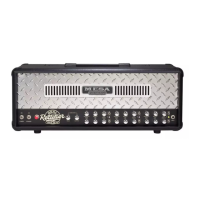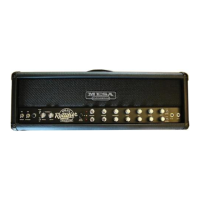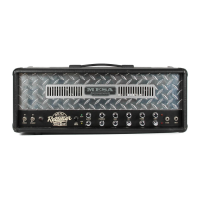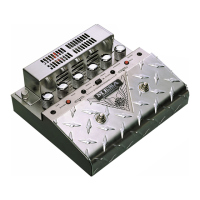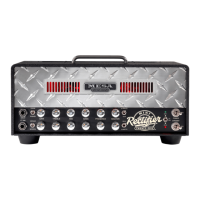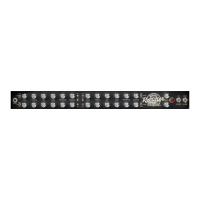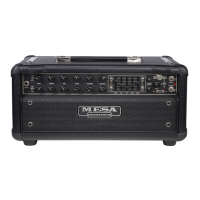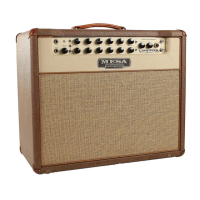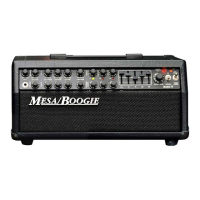PAGE 4
CHANNEL 2:
TWEED:
This is the lowest gain of the three Modes in Channel 2 and is aimed at clean and edge of clip sounds. It draws the
framework of its circuit architecture from the early tweed amps from Southern Cal and then gets a healthy dose of magic from the 40
years of little secrets we’ve discovered to arrive at a beyond vintage level of Tone and performance.
When using TWEED for clean work the 15W and 25W (Dyna-Watt) Power Modes provide the best blend of
sparkle, warmth and headroom – with the 25W being the obvious choice for live performance situations. To
explore the world of soft clip sounds in TWEED, set the GAIN high (3:00 – 5:30), the BASS low (8:00 – 10:30)
and ponder the differences in 5W and 15W until you find just the right response for your needs.
Just keep in mind that it is always a good idea when looking for overdriven sounds, especially in the TWEED
and NORMAL Modes, to reduce the BASS setting as you increase the GAIN control. This will avoid flubbiness and keep the attack
tight and focused.
HI 1:
We’re back across the water again for a high gain tribute to the other great British amp and HI 1 captures all the tight attack,
thumpy, tight bottom and midrange cut for which these amps are famous. HI 1 is the choice anytime you need attack and a higher,
quicker feeling bottom end response.
Many players prefer this circuit for crunch or overdriven rhythmic playing, citing its percussive nature tracks tighter in the hands and
is more defined in a mix. It also shines for use with shorter scale mahogany guitars that have a woodier, throatier top end and more
lower midrange as a dominant part of their character.
When looking for single note solo sounds in HI 1 it may be necessary to run the TREBLE a little lower than you would for high gain
chording, say somewhere in the 9:30 – 10:30 range to soften the attack and round out the notes a bit for a smoother more vocal
character. When dialing up lower gain sounds in HI 1, whether for chording or lead work, try setting the BASS rather high - 1:30 –
3:30 – to add air and girth to the sound. In general, you can apply the BASS a little more liberally in HI 1 than in some of the other
Modes as the increased upper midrange attack present here will keep things tighter longer and the frequency of BASS is a bit higher
than in HI 2, so it can follow the attack a little easier in the time domain.
As far as power matching, HI 1 is pretty friendly with all three choices, however 15W and 25W showcase the classic Brit response best
with 15W leaning toward smoother soloing and 25W excelling at tight percussive chording. The 5W position works good for lower to
medium gain soloing, but don’t expect it to be as tight or percussive for the rhythmic work as the two higher power Modes.
HI 2:
Grab your suitcase, as again we cross the Atlantic on our tour of the world’s most classic guitar sounds. This time we’re back
to Sonoma County, famous for wine and high gain guitar sounds. HI 2 is all about Boogie. Smooth, round attack, molten sustain and
lined up layers of harmonics. This Mode is all about soloing. While you are welcome to explore its virtues for chording, it is single
notes that most benefit from the deeper lows, slightly tucked mids and higher harmonic landscape found in this classic sound.
In the Tr a n s aT l a n T i c however, for continuity’s sake, we’ve leaned just a pinch in the direction of HI 1 – slightly higher mid frequencies,
a little more attack and a touch higher BASS than in other Boogie lead modes for two reasons. First, lower power amplifiers are simply
not capable of pushing (steering/controlling) sub-low frequencies like their high power counterparts. They choke and lose definition
when the BASS is too low and use all their available power trying to drag the low frequencies around. Second, guitarists – for the
most part - are extremely conservative when it comes to sounds. Since most of us grew up listening to the same references, we want
to hear easily identifiable classic sounds that fit into a category when we try an amp or guitar. We’ve seen over the years that players
tend to stumble when there is a sound or mode in an amp that strays very far outside the “basic vibe” or style they perceive to be its
“thang”. For this reason we found it instantly more digestible to more players when we keep things more closely related.
Th e MO d e s : (Co n t i n u e d )
GAIN
NORMAL
15 15
HI 1
TOP BST
25W
FT
SW
5W
TWEED
HI 2
25W
5W
MASTER
PULL
CUT /
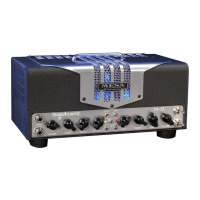
